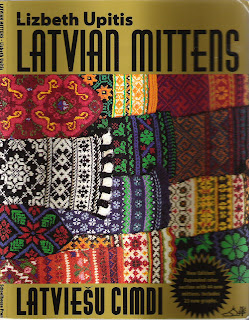Those Famous Latvian Mittens
 My female Latvian friends are mostly English teachers and academics. Two are weavers, although one has sold her loom because she works all the time and it takes up too much space in her apartment. These friends were bemused when I told them that the hand-knit, colorful mittens are among the (few) things Americans know about
My female Latvian friends are mostly English teachers and academics. Two are weavers, although one has sold her loom because she works all the time and it takes up too much space in her apartment. These friends were bemused when I told them that the hand-knit, colorful mittens are among the (few) things Americans know about  The person who raised
The person who raised
A spin-off resulted when Lizbeth loaned Joyce Williams some books on Latvian weaving (A Joy Forever, Latvian Weaving, Traditional and Modified by Jane A. Evans, 1991, and several Soviet-era Latvian books by Z. Ventaskrast from the 1950s with weaving patterns). As Joyce says in her book Latvian Dreams: Knitting from Weaving Charts (Schoolhouse Press, 2000): “…looking at some of the [weaving] charts…I felt they would make excellent knitted designs.” Between the two of them, Lizbeth and Joyce have published enough Latvian patterns  to keep all of us endlessly knitting stranded colorwork mittens, socks, sweaters--and wherever our needles and imaginations lead us.
to keep all of us endlessly knitting stranded colorwork mittens, socks, sweaters--and wherever our needles and imaginations lead us.
Latest Latvian knitting news
Those patterns keep showing up. In the recent issue of Interweave Knits (Summer 2007), Kate Gilbert adapted a motif that she found on a traditional Latvian mitten to develop a pattern for a cap in three sizes (child’s, woman’s, and man’s) and three color ways (see pages 45 and 108).
In the same issue, Deborah Pulliam devoted her regular column “Knitted Artifact” to the Latvian mitten-making project for the NATO summit in
NATO Mitten Project
Latvia was admitted to the North Atlantic Treaty Organization in 2004, hopeful that NATO membership might provide some security from Russia, its large neighbor and past subjugator (which still refers to Latvia as the “near abroad”). The honor of hosting a NATO summit in 2006 led to feverish preparations last summer and fall. Someone in public relations came up with the idea of presenting each of the 4,500 guests at the summit with a pair of handmade Latvian mittens. Knitters from the countryside were recruited and paid $12-14 per pair to knit these devilishly difficult mittens (on 0 or 00 double-point needles). Of course, the knitters rose to the occasion and examples of the results have been preserved online (in a huge zipped file). I’m providing links to postings on the NATO Summit website entitled “The story of a 1,000-year-old Latvian mitten” and “Renaissance of Latvia’s ethnographic mittens.” Also to designs from Mirdza Slava's classic Cimdu Raksti on Latvian mittens and the NATO collection.
 In
In  throughout the museum.
throughout the museum.
If you’d like to learn some of the techniques for Latvian mitten embellishments (braids, fringe, cast-on, scalloped and picoted borders), I'll be offering a knitting session during our ferry ride from

0 Comments:
Post a Comment
Subscribe to Post Comments [Atom]
<< Home